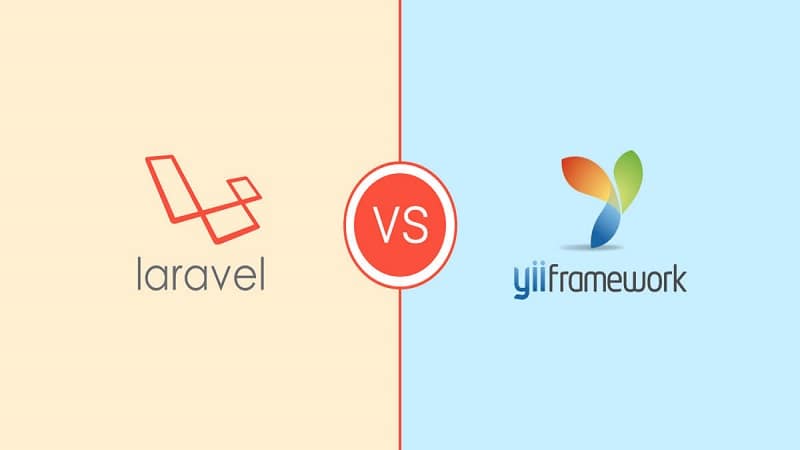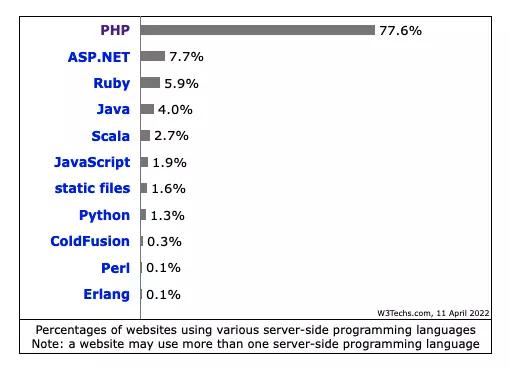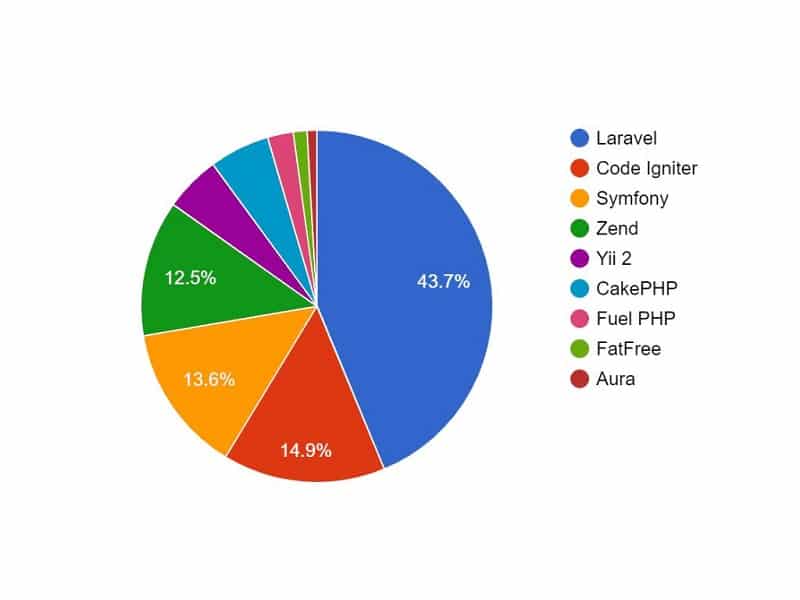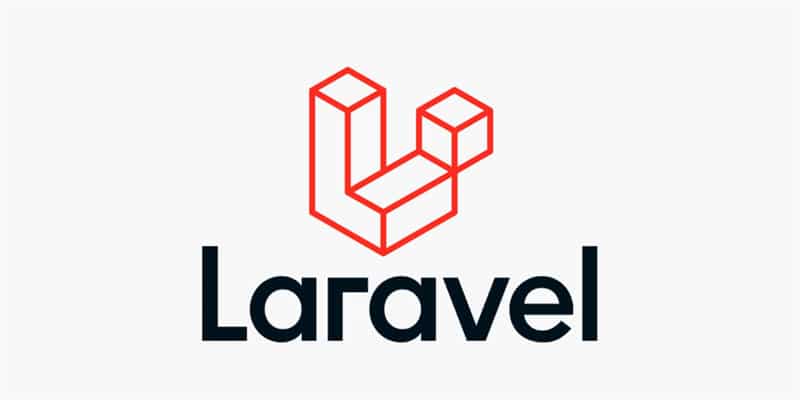
PHP was first released in 1995 and is today on its 8th version. And a whopping 79.2% of websites are programmed using PHP.
So unlike popular belief, PHP isn’t dead.

Within PHP, Laravel is one of the most widely used.

But as you can see from the above illustration, Yii isn’t far behind. Both of these PHP frameworks help make writing code easier. But each comes with its own pros and cons that a talented PHP developer can exploit. In this article, we’ll discuss the differences between Laravel and Yii and delve into their pros and cons.
What is Laravel?

Laravel is a backend PHP framework that boasts of having an elegant and expressive syntax. Laravel is a developer-friendly framework. It makes tasks like authentication, routing, coaching, and sessions a breeze.
Even with all of its simplifications, Laravel doesn’t compromise on any of the functionality. It reuses the existing components of various other frameworks to help speed up the web application creation process. If you’re building an app using PHP, hire a Laravel developer to help accelerate the process.
What is Yii?

Yii is yet another PHP framework that is open-source and object-oriented. Yii is a Japanese word meaning “simple and evolutionary”. And that is exactly what the framework offers to its users.
Yii is a flexible, fast, and secure framework that works with the MVC model. Yii is usually used for developing large-scale web applications. It is lightweight, so your application can retain speed and loading time.
Now, let’s discuss the differences between the two PHP frameworks and how they’ll be of use to you.
Key Differences between Laravel and Yii
1. Software Installation
Laravel
Installing Laravel into your system is a bit of a process. You first need to install composer, which manages its dependencies. Then, you can install Laravel software using composer.
Your system has to have PHP of 5.4 or greater and an MCrypt PHP extension for Laravel to work.
Yii
The recommended method to download Yii is through Composer. You can also download an archive file and then extract it to a web-accessible folder.
The only system requirement for Yii is that you should have a PHP of 5.4 or greater.
2. Performance
Laravel
Laravel employs approaches like class-map optimization and routing to speed up the performance. You can optimize Laravel’s performance by using appropriate packages and artisan commands. But despite this, Laravel is slower than Yii.
Yii
Yii is known to have high performance. It is, in fact, the fastest PHP framework for web development. It increases the page’s loading time. So if you’re going for a better-performing web application, then Yii should be your framework of choice.
3. Debugging
Laravel
Laravel has its own debugging system which you can use to clean up the code. dd() or “dump and die” is a command which you can use to debug your web application. dump() is another such command.
You can also install tools like Laravel Debugbar and Laravel Telescope to make the job even easier for yourself.
Yii
Yii has in-built debugging tools for quicker debugging. There is a debugging console that shows you the toolbar at the top of the page. This will show the executed paths of all of your application’s URLs.
The console effectively gives you all the details of your web application’s status. With this, you can easily debug the application.
4. Routing
Laravel
Laravel developers need to declare the route for every action they make in the controller. All of your application’s routes will be mapped within the app/routes.php file.
The benefit of this is that it has fast and capable versioning of multilingual websites.
Yii
In Yii, the developer does not need to route all the actions. This makes it quicker to write code and develop the web application. All the route actions are picked by default. So the developer has less work to do when working with Yii.
5. CRUD Generation
Laravel
Laravel does not have an in-built tool for CRUD generation. You will need to use 3rd party generators. These include Craftable, CRUDBoosters, and LaravelCRUD Generator.
CRUD is what ensures that the app functions properly and makes it interactive. So it is imperative to have a robust tool for this.
Yii
Yii has a tool called Gii that permits prototyping. It does this by generating utilized code fragments or CRUD controllers.
Yii also has a web-enabled liaison. This helps developers generate codes automatically. It also provides a command-line structure to make it easier to develop the web application.
6. Support
Laravel
Laravel has the highest ranking from Github stars. As it is an open-source framework, it has huge community support from developers worldwide. The community for Laravel is also ever-growing.
Yii
Though the Yii community is older, it is not as active as Laravel’s community. Since Yii is older, there are more developers using it than Laravel.
So both frameworks are pretty well-matched when it comes to community support.
7. Scalability
Laravel
Laravel has command-line tools which help to create skeleton code. These will help carry out activities like migration and composition.
Laravel also does not require XML configuration. This makes it simple to use. It is also a full-stack framework that can handle all of your key tasks. So Laravel scores high when it comes to scalability.
Yii
Yii is an OOP-based framework that is easy to use. It boasts of having good configuration code which can be used to generate template codes for modules and extensions quickly.
8. Use Cases
Laravel
Laravel is best for e-learning and blogging websites. It allows you to manage a scaling website very easily. So the end users can easily add more blogs and learning modules to their website without facing issues like slow loading time.
It also allows the user to integrate functions like sharing on social media websites or newsletter subscriptions.
Building e-commerce websites is another application that Laravel comes in handy. You can integrate payment and marketing tools to enhance the user experience.
Yii
Yii is best when it comes to developing large-scale applications. This includes forums and portals. Yii can easily handle applications that will receive a large traffic in-flow without slowing down.
Content Management Systems and e-commerce websites are other use cases where Yii will be extremely useful.
Which to choose?
If you’re thinking about keeping the website simple, then Yii will be the best choice for you. But if you want to build a dynamic web application that is scalable, then choose Laravel.
If you've hired a talented Laravel developer, then you have the freedom to build a robust web application that has high performance.
At the end of the day, your end goal is what will decide which framework to use as both harbor a sea of benefits.










